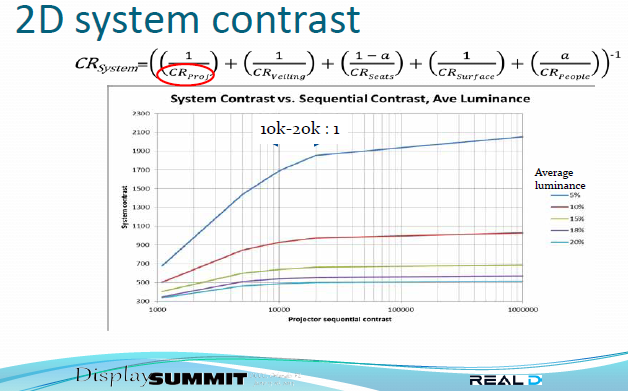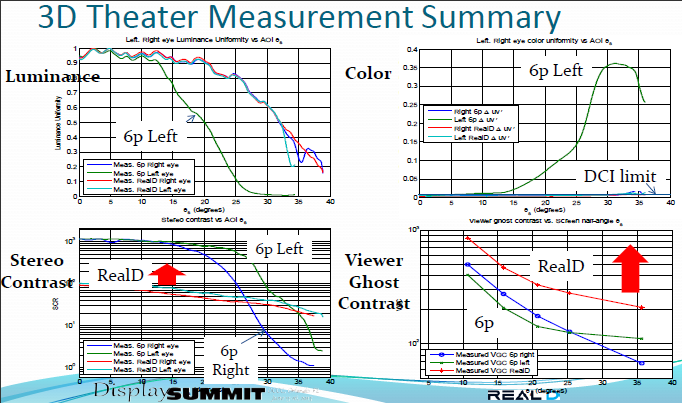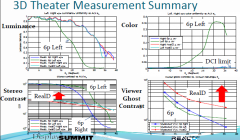
Miller Schuck is from RealD and he talked about contrast in the cinema. Laser projectors are here now – they can deliver good HDR, colour and really black blacks. Can 3D keep pace with 2D in this development, Schuck asked? RealD wants to make 3D cinema as good as 2D.
In a cinema environment, lots of factors affect the overall contrast on the screen and he said that 0.3 to 0.7 nits of brightness can come onto the screen just from reflections from the seats alone when part of the image is bright.
You can measure contrast using a pattern and Real D then uses an occlusion disc to cast a shadow, to understand what light is coming from where. In the real world of a cinema, DLP’s contrast gradually goes down from 2000 to around 1100:1, with losses coming from veiling glare in the optics and then room contrast is around 1445:1 so the final contrast on the screen is around 350:1 for the whole system, and it’s system contrast that is what the viewer sees.
In movies, Schuck said, 50% of the content is below 5% brightness and 90% is below 20% brightness, so often you are dealing with relatively little light on the screen. In looking at the impact of projector contrast on the overall system contrast. There’s a “knee” in the curve at around 10,000 to 20,000:1. Increasing projector contrast from there makes little difference to the system contrast, so there’s not much point in going above that level.

Next he turned to 3D encoding, and he looked at the balance between polarisation and six primary projection. A big advantage of six primary is that it enables white screen use, rather than needing a polarisation-retaining screen. Polarisation uses low cost glasses.
Schuck said that RealD had looked at image quality metrics in a lot of detail. Image quality can depend on screen geometry and this can be a real issue in Premium Large Format (PLF) cinemas where throw ratios can be even 1.5 and lower. PLF is getting more popular and pulling in money for cinema owners, but the big screens mean wider viewing angles.
In PLF installations with six primary projectors, the wide viewing angle can mean a “blue shift” especially in the left eye and at 25 degrees you start to get ghosting. You can calculate both the wanted light and unwanted light. Up to 30 degree viewing angle is fine for the right eye, but the left eye image drifts much earlier. Six primary gives great on axis contrast, but the left eye falls off a lot.
RealD also did measurements on a new concept “Viewer ghost contrast”. This is caused because a lot of the light comes through the glasses, bounces off the viewer’s skin and reflects back again off the glasses and you see the reflection. RealD said that this was inherent with the glasses used for six primary systems. RealD measured this and said that there was a paper presented at SID (66.1 Feasibility of 3D Cinema with Uncompromised Performance)
In contrast ratios, six primary is better on axis, but falls off, while polarisation is more even over all viewing angles.

In conclusion, Schuck said, 10,000 to 20,000:1 is enough contrast for high quality. In questions, he said that an HDR projector at 10,000:1 could give you 1900:1 system contrast which is a big improvement on today. 3D systems, though, depend critically on the type and quality of 3D encoding.
A questioner asked “does the viewer want better?” and Schuck said “Definitely”. Polarisation systems vary more according to viewer position.
To a question about roll off differences between Xenon/laser, there was general agreement that laser was better.
Analyst Comment
I, and others, noted the reflections in my first six primary projection show at IBC and we assumed that as the technology was new, this was some kind of early problem, but RealD is convinced that the problem is inherent. The comments about viewing angles (which get worse if you are near to the screen) also might explain why Christie was keen to get VIPS such as the press into the allocated block of seats at the optimum viewing position!
Dolby, of course, licenses the Infitec 6P system and we heard at Infocomm that Infitec has a completely new approach that it will reveal shortly that solves the problem by using a completely new concept – and is promised to dramatically cost reduce the glasses. (Infocomm Round-up) (BR)

